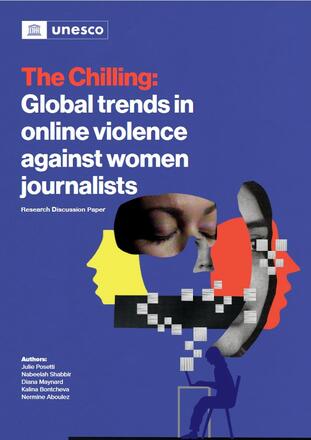
This paper is an output of a wider UNESCO-commissioned global study on online violence against women journalists.
Among the findings:
37% of women survey respondents identified political actors as top sources of online attacks against them.
20% of all women survey respondents experienced abuse and attacks in the physical world that they believe were seeded online.
17% felt physically unsafe as a result of online violence.
12% of women survey respondents sought medical or psychological help.
There is nothing virtual about online violence. It has become the new frontline in journalism safety and women journalists sit at the epicentre of risk. Networked misogyny and gaslighting intersect with racism, religious bigotry, homophobia and other forms of discrimination to threaten women journalists - severely and disproportionately.
This phenomenon is also bound up with the rise of viral disinformation, digital conspiracy networks and political polarization.
Online violence against women journalists is designed to: belittle, humiliate, and shame; induce fear, silence, and retreat; discredit them professionally, undermining accountability journalism and trust in facts; and chill their active participation in public debate.
Online attacks on women journalists appear to be increasing significantly, particularly in the context of the ‘shadow pandemic’ of violence against women during COVID-19. The pandemic has changed journalists’ working conditions, making them yet more dependent on digital communications services and social media channels.
Online violence against journalists is a significant feature of what we call ‘platform capture’, which involves the weaponization of social media by bad-faith actors, in combination with the structural failures of the platforms’ business models and product design, and the virtual entrapment of many news organizations and journalists into platform dependency.
In Northern Ireland, online violence against women journalists has taken a sectarian turn.
Online violence based on religious and associated cultural factors amplifies the risks to women journalists who are targeted in such ways, especially in countries where perceptions of immorality or blasphemy can trigger backlash, and even offline attacks.
Online violence against women journalists is a global phenomenon.
For too long, the emphasis has been on making women journalists responsible for their own defence and protection, rather than making the perpetrators and instigators, the platform enablers, and law enforcement and media employers accountable.
These methods of attack are growing more sophisticated, and they are evolving with technology. They are also increasingly networked and fuelled by political actors.
Most women journalists do not report or make public the online attacks they experience, in line with low levels of reporting when it comes to violence against women more broadly.
Many media employers still appear reluctant to take online violence seriously.
In conclusion, all stakeholders could recognize that the problem of online violence is transnational and operates in the context of huge and profitable technology companies.
Intergovernmental organizations could recognize and work to counter the role of officials active in facilitating and orchestrating large-scale and continuous online attacks on women journalists.
Individual States could make social media companies more clearly accountable for combating online violence against women journalists.
Political parties could punish members and officials who partake in acts of online violence against women journalists.
Platforms could continuously review their policies to address the ever- evolving nature of online violence.
Media organizations could ensure online safety support is holistic, as well as responsive to intersectional threats/ impacts, and readily available to all staff and freelancers.
Civil society organizations could help raise awareness and educate women journalists and editors in online safety, effective use of platform tools for countering online abuse, employer advocacy, and legal support.
Tags: Media and gender Hate speechThe content of this article can be used according to the terms of Creative Commons: Attribution-NonCommercial 4.0 International (CC BY-NC 4.0) . To do so use the the wording "this article was originally published on the Resource Centre on Media Freedom in Europe" including a direct active link to the original article page.

